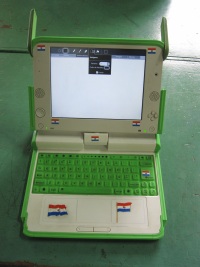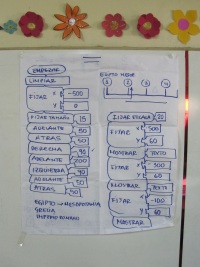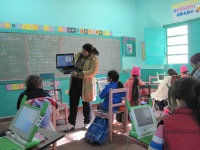Even though I had heard quite a bit about ParaguayEduca's OLPC / Sugar efforts from Daniel Drake and Bernie Innocenti (aka "the olpc volunteer rock stars") it wasn't really possible for me to grasp how the project was going until I spent two weeks in the country as part of my ongoing OLPC News South America road trip.
Note that I wrote "OLPC / Sugar efforts" because - unlike most other deployments I'm aware of - ParaguayEduca has spent a lot of resources contributing to the Sugar platform. The organization's technical team hasn't just fixed bugs and made slight customizations but in combination with work contributed by Plan Ceibal's developers and others they have improved and enhanced Sugar in more than one way. I'll dive into the details in a separate article so for now you'll just have to believe me that their build 353pyg has turned my XO-1 into the best machine it's ever been. (If you're interesting in testing the latest Release Candidates yourself then head over here.)
I also found it really interesting that ParaguayEduca recently started testing new Sugar versions with a 6th grade class before rolling them out to their whole 4000 XOs deployment in the city of Caacupé. There are many bugs or issues that software developers themselves would never find even though they become immediately visible when observing a child using Sugar. Therefore this is a great way to get feedback and improve things before upgrading a large number of XOs.
Additionally ParaguayEduca has also developed Inventario, a backend logistics solution that they made available as open-source software. Inventario also deserves a separate article to explore all the functionalities it provides for things like tracking XOs undergoing repair, network status and spare parts supplies. It's really quite a cool piece of software and I really suggest that everyone who is planning to run or is already running a mid- to large-size deployment should take a look at the Inventario demo. Especially because it's a good way to realize just how many things one needs to consider when running a 1-to-1 computing in education project.
One the educational side of things ParaguayEduca is probably the South American deployment that's closest to the constructionist way of learning that OLPC and Sugar are often associated with. From what I understand Paraguay's curriculum is quite constructionist to begin with so that's certainly a good foundation.
In practical terms this means that the educational team - with support provided by OLPC's Claudia Urrea - has so far focused a lot on Scratch. This focus is certainly visible in the pupils with XOs as some of them have done amazing things such as creating extensive games or telling great stories with Scratch. Walter Bender also recently visited Paraguay and held a workshop on Turtle Blocks (the Activity previously known as "Turtle Art") so I'm sure we're soon also going to see some great examples of Turtle Block use.
Needless to say other pupils have been equally creative when it comes to installing new software on their XOs. My personal favorite in that area was the 6th grader who downloaded and subsequently played a demo of Age of Empires II (a very popular real-time strategy game for Windows which I spent a fair share of my teenager years on) via Wine!
In terms of teacher training ParaguayEduca's approach is also the most extensive one in an OLPC deployment that I'm currently aware of. Rather than training the teachers themselves ParaguayEduca's educational team hired people who they then trained to become "formadores" (teacher trainers). Apart from leading the teacher training sessions these formadores, currently there's 16 of them, spend a lot of time in schools in order to support the regular teachers when it comes to the integration of the XOs in the teaching process.
Additionally all teachers of classes that will receive XOs over the coming months are currently in the process of receiving 150 hours of training before the XOs arrive at their schools. Just to give you a comparison: the Peruvian teachers that are part of the country's "Una laptop por niño" program received 40 hours of training.
With regards to connectivity ParaguayEduca collaborated with Personal, a large telecommunications provider, to setup a WiMAX backbone that connects all the schools which are part of the current 4000 XOs rollout to a 14MBit uplink to the Internet. Additionally Personal is supporting the project by providing this connectivity for free for two years.
All in all it shouldn't be too hard to see that I was seriously impressed by the status quo of ParaguayEduca's project. They have done a great job of building up the team, processes, infrastructure, software and educational capabilities that are necessary for a successful implementation of one laptop per child in Paraguay.
The big question now is how well all of these structures and processes will scale as the project's size more than doubles from the current 4000 XOs to approximately 9000 XOs over the coming months. This growth will be challenging for all areas of the initiative, ranging from how XOs are repaired to how to deal with weak formadores (which of course also exist). In terms of long-term sustainability it will also be interesting to see how keys aspects like the Internet connectivity are maintained and financed once the support from Personal ends.
It's obviously not possible to simply throw twice as many resources at everything so the core challenge for ParaguayEduca over the next 12 to 18 months will be how to grow what is an effective project into one that is also efficient on a potentially nation-wide scale.
However based on the organization's track record so far I would say that it is in a very good position to run a successful OLPC / Sugar project over the coming years. Therefore I would highly recommend everyone in the OLPC / Sugar and larger ICT4E context to keep a close eye on ParaguayEduca's work - and of course also the evaluations of its work by organizations such as the Inter-American Development Bank - over the coming months and years.
P.S. Click here to see more of my olpc-related photos from Paraguay.




